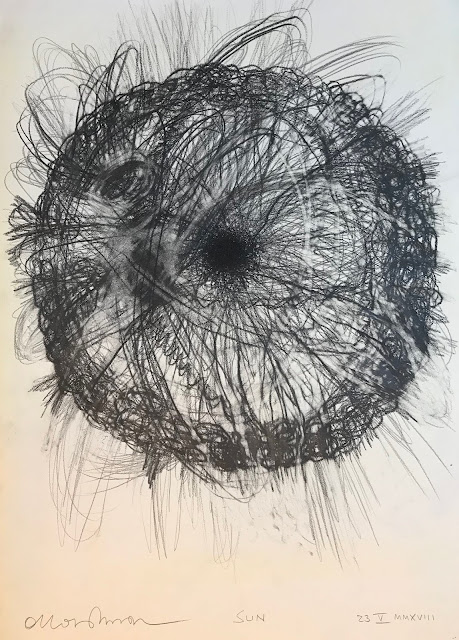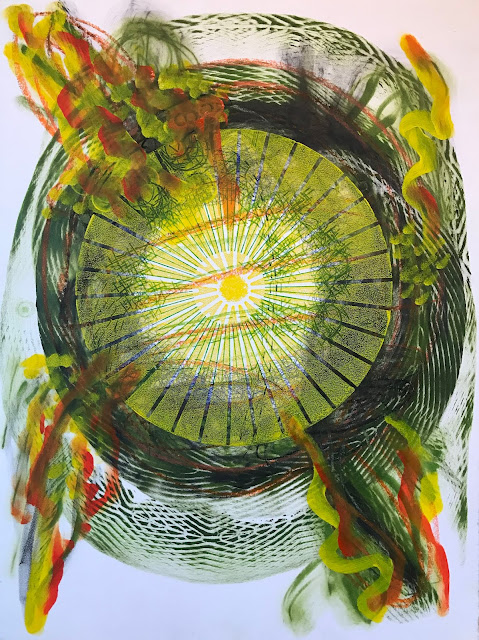THE SUN AS BIG AS YOUR HEAD
May 20 - 26, 2018
Charcoal, graphite, oil on Stonehenge paper 76 X 56 cm
I've been drawing portraits of the Sun. The two main things you can't look at directly are the sun and your head.
The Sun is simple at heart, because great things are simple. The core is a thermo-nuclear fusion reactor. Hydrogen fights until it becomes helium. Yin and Yang know all about this.
The Sun has no true surface, there's nothing solid. It's made of struggle. Pressure from within and gravity from without come to terms so that all the fury stays in a ball. ( Thanks Ron Chisholm for explaining this to me )
The matter that makes up the Sun extends well beyond our Earth, far out into the solar system. It's entirely accurate to say that everything in our solar system, including all eight ( maybe nine ) planets, exists "inside" the Sun.
The core is as lightless as the bottom of the sea. When hydrogen fuses into helium, photons of light are thrown off at the end of a chain reaction. It takes millions of years for any given photon to cross the dense interior to get to the convection zone, the part that looks like a bubbling stew.
The radiative zone stretches from the outer core to 70% of the Sun's radius. Superheated ions of hydrogen and helium emit photons which travel a short distance and then are constantly reabsorbed by a neighbouring ion. This is the zone of trying and failing, then failing better. But then when it fails best and the light can finally escape, it only takes eight minutes to get over here to us.
The convective zone extends from the outer edge of the radiative zone to the photosphere, the visible surface of the Sun. The thin boundary between the zones, the tachocline, is the big wheel that changes the two forms of energy into magnetic fields.
The tachocline generates a north-south magnetic field, then is pulled into an east-west pattern as different layers of the Sun rotate at different speeds. The stretching adds energy to the lines, which break through the surface as sunspots, or soar into the corona as loops and prominences.
The photosphere is the point at which photons --visible light-- can finally escape into space. Since our sight depends on detecting photons that have travelled from the Sun, this zone is as far into the Sun as we can see without the aid of drawings. Because photons can't escape until they reach the photosphere, even even if we could see deeper into the Sun, everything below the photosphere would be pitch-black.
Just above the photosphere is the mostly invisible chromosphere. If the photosphere is the surface of a boiling stew, the chromosphere is where the stew spits and splatters. It's where solar prominences --filaments of superheated plasma-- anchored in the photosphere whip about.
The halo-like corona is the Sun's outer atmosphere, where plasma particles flow nonstop into space as the solar wind. When the Sun's rotation brings these areas toward Earth, auroras increase and the wi-fi goes bonkers. The corona can reach temperatures of nearly ten million degrees Celsius, far hotter than the surface of the Sun. We've only known this since the 1920s, when scientists found evidence of ionized iron, which can only be formed at super-high temperatures, in the spectral signature of light emanating from the corona.
Before there was anything it was dark, and there was only Nothing. And the Prime Mover said, Let There Be Light. And there was still Nothing. But you could see it.












No comments:
Post a Comment